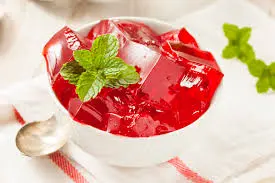Can a Dog Eat Jelly? A Comprehensive Guide
As a dog owner, it’s natural to wonder what foods are safe for your furry friend. One common question that arises is, “Can a dog eat jelly?” While jelly is a popular treat for humans, the answer isn’t as straightforward when it comes to our canine companions. In this article, we’ll explore the ingredients of jelly, its potential risks and benefits for dogs, and what you should know before sharing this sweet treat with your pet.

What is Jelly?
Jelly is a sweet, spreadable food made primarily from fruit juice, sugar, and pectin. It’s often used as a topping for bread, toast, and desserts. The primary ingredients in jelly can vary, but they generally include:
- Fruit Juice: The primary flavoring agent, providing natural sweetness and flavor.
- Sugar: Often used in large quantities to sweeten the jelly.
- Pectin: A thickening agent derived from fruits, helping to create the gel-like consistency.
While jelly can be delicious for humans, the question remains: Is it safe for dogs?
Can Dogs Eat Jelly?
The short answer is no, dogs should not eat jelly. Here’s why:
1. High Sugar Content
One of the main concerns with jelly is its high sugar content. Dogs have different dietary needs than humans, and excessive sugar can lead to various health issues in dogs, including:
- Obesity: Just like humans, dogs can gain weight from consuming too much sugar. Obesity can lead to serious health problems, such as diabetes, joint issues, and heart disease.
- Dental Problems: Sugar promotes tooth decay and gum disease. Regular exposure to sugary foods can significantly increase your dog’s risk of dental problems.
2. Artificial Ingredients
Many commercial jellies contain artificial colors, flavors, and preservatives. These additives can be harmful to dogs and may cause allergic reactions or gastrointestinal upset. Always check the ingredient list if you consider sharing any human food with your pet.
3. Xylitol Poisoning Risk
One of the most significant dangers associated with jelly, especially sugar-free varieties, is the presence of xylitol. Xylitol is a sweetener that is safe for humans but highly toxic to dogs. Even small amounts of xylitol can cause rapid insulin release in dogs, leading to hypoglycemia (low blood sugar), seizures, liver failure, or even death. If you suspect your dog has ingested jelly containing xylitol, contact your veterinarian immediately.
4. Gastrointestinal Issues
Dogs have sensitive digestive systems, and consuming jelly can lead to gastrointestinal upset. Symptoms may include:
- Vomiting
- Diarrhea
- Abdominal pain
If your dog shows any of these signs after consuming jelly, it’s best to consult your veterinarian.
Healthier Alternatives to Jelly for Dogs
If you’re looking for safe and healthy treats to share with your dog, there are many alternatives to jelly that can provide a delicious and nutritious experience. Here are some suggestions:
1. Fruit Purees
Consider giving your dog pureed fruits such as applesauce or mashed bananas. These options are lower in sugar and provide natural vitamins and minerals. Just ensure that the fruit is safe for dogs and does not contain added sugars or artificial ingredients.
2. Peanut Butter
Many dogs love peanut butter! It’s a great source of protein and healthy fats. Ensure that the peanut butter you choose is free from xylitol, which can be toxic to dogs. You can spread a small amount on a dog-friendly treat or use it to fill a Kong toy.
3. Pumpkin Puree
Plain canned pumpkin (not the spiced pie filling) is a nutritious and tasty option for dogs. It’s high in fiber and can aid in digestion. Mix a spoonful into your dog’s regular food or serve it as a treat.
4. Homemade Dog Treats
You can also make your own dog treats using wholesome ingredients. Many recipes incorporate peanut butter, pumpkin, or fruit purees to create tasty and nutritious snacks for your pet.
5. Carrots and Apples
Both carrots and apples (with seeds and core removed) make excellent low-calorie snacks for dogs. They are crunchy and enjoyable, providing added fiber and nutrients.
Signs Your Dog Has Consumed Jelly
If you’ve accidentally given your dog jelly or if you suspect they’ve snuck some, it’s essential to monitor their behavior for any signs of distress. Some common symptoms to watch for include:
- Vomiting: If your dog vomits shortly after consuming jelly, it may indicate an upset stomach.
- Diarrhea: Loose stools or diarrhea can occur if your dog’s digestive system reacts poorly to jelly.
- Lethargy: Unusual tiredness or a decrease in activity may indicate that your dog is not feeling well.
- Loss of Appetite: A sudden decrease in appetite can signal that your dog is experiencing gastrointestinal discomfort.
- Abdominal Pain: Signs of discomfort, such as whining or reluctance to move, may indicate that your dog is experiencing pain.
If you notice any of these symptoms, it’s essential to consult your veterinarian for guidance.
Educating Yourself About Dog Nutrition
As a responsible dog owner, educating yourself about what foods are safe for your pet is crucial. Here are some tips for keeping your dog healthy:
- Read Labels: Always check the ingredient lists on food products to ensure they do not contain harmful additives.
- Research New Foods: Before introducing any new treat, research its safety for dogs or consult your veterinarian.
- Stick to Dog-Safe Treats: Choose treats specifically designed for dogs, as they are formulated with your pet’s dietary needs in mind.
- Maintain a Balanced Diet: Ensure that your dog’s diet is well-balanced and meets their nutritional requirements.
Conclusion
In conclusion, while jelly may be a delightful treat for humans, it’s not a safe choice for dogs. The high sugar content, potential for harmful additives, and risk of xylitol poisoning make jelly a food best kept out of your dog’s reach. Instead, consider offering healthier alternatives like fruit purees, peanut butter, or homemade dog treats to satisfy your pet’s sweet tooth.
By being mindful of your dog’s diet and avoiding risky foods, you can ensure that your furry friend enjoys a happy and healthy life. If you ever have doubts about what foods are safe for your dog, consulting your veterinarian is always a good practice.
